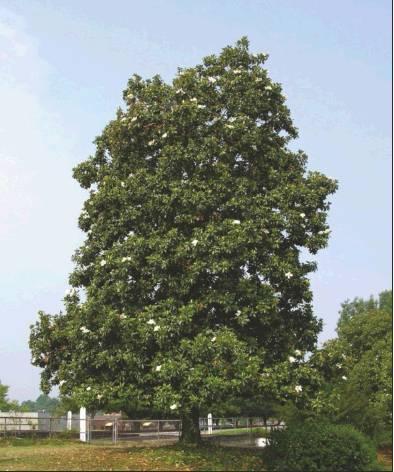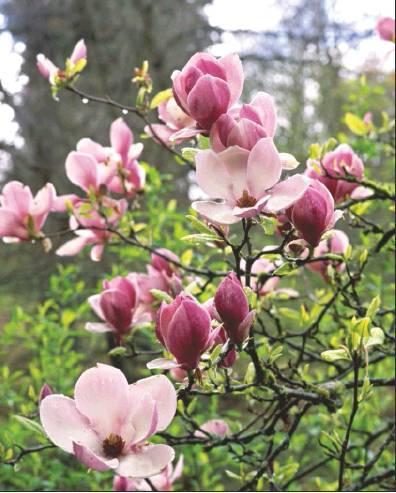Getting into Gardening
Say “magnolia” and most people envision large shade trees with fragrant blossoms that evoke the American south. True, some grow as big as 70 feet, but with 12 species and hundreds of varieties, including ones that flourish as far north as Maine and Minnesota, there’s a magnolia variety for everyone.
“Think of magnolias as you might fashion - there’s a size, shape, style, and color suited to the decor of just about any garden, even the smallest,” says Judie Evrard Brower of Tesselaar Plants, an international plant research company. “Some can even be container-grown.” And don’t think for a moment that they’re fragile. “Magnolias are easy to care for and disease-resistant,” Brower says. They’re also versatile; they can grow as a hedge or be trained to climb up a lattice against a wall.
Southern magnolias, Magnolia grandiflora, are widely considered to be one of the most beautiful and sought-after tree species in the Southern and Western United States. It is the majestic magnolia we see all over the central Texas area. Not only are they often extremely large at maturity, but they live for upwards of 100 or more years under the right conditions and explode all summer long with the most amazingly large and striking white flowers throughout their entire canopy. They are simply gorgeous.
Here in central Texas, caring for magnolias can take a small amount of effort. Although the species will grow here, even in rocky soils, their needs really should be assessed based on each individual site. Our soils vary widely. Some soils such as those of Dripping Springs and Wimberley are very rocky and riddled with shallow limestone and very little good soil (except near the river where the soil can be great!). The rocky soils are very high pH (alkaline) soils. Other areas such as downtown and East Austin, and Northwest Hills have much deeper soils. Areas by Lake Austin have flat alluvial and extremely fertile soils from years of silting and produce magnificent specimens. East of IH35 in Kyle and Buda the soils are a heavy black clay.
Having cared for magnolias in all these areas, I find that most of the problems magnolias have are soil related. Additionally, compaction and lack of mulch often exacerbate already poor soil conditions. Lack of water, in addition to one or more of these factors, is also a limiting factor in the summer months especially. Soil amendment helps, add finished compost as a top dressing around but not touching the trunk out several feet or better yet, out to the edge of the canopy, this will help with water retention and will lower the pH a bit. Also mulch to 3 inches (max) and keep your trees well watered during the hot summer months and you will find your magnolia is no longer thinning or stunted.
Magnolias are one of those species that, in addition to their macro-nutrient requirements (N,P,K,S,Ca,Mg), they also require certain micro-nutrients in larger amounts than other species. Iron and Zinc are two of the most widely lacking micro-nutrients for magnolias in this area. Zinc, for example, is needed for the blooms. Iron is needed to prevent interveinal chlorosis (yellowing between the leaf veins). Additionally, magnolias thrive in low pH, acidic soils. Although they will grow in alkaline rocky soils, they do not get large and grow very slowly, and are of course more prone to nutrient deficiencies, the compost really helps with this.
In addition to general soil amendment and mulching, yearly fertilization is also helpful. When I apply a general slow-release, organic, granular fertilizer I will sometimes add a magnolia ‘micro’ mix to add missing micro-nutrients. Though more and more I find that adding the compost really does the trick. I have brought many magnolias back in the central Texas area over several years, and find that they will thrive if given the right minerals, mulch, water and soil conditions, including lowering the Ph. If you have a stressed or stunted magnolia follow the guidelines above and its problems will be gone in no time at all.
So how about some of those other varieties I said existed? Some of my favorites are the complete opposite of the huge magnolia trees we envision when we close our eyes, they are dwarf magnolias and can grow well in our area and even in small spaces or containers.
One of the best-known dwarfs is Magnolia “Little Gem.” Although this cultivar can grow to twenty feet, it does so very slowly. Little Gem is an evergreen, hardy in zones 5 through 9. The upright tree produces white flowers with a delicious fragrance. Little Gem can be grown successfully in containers if you prune it back to control its size and spread. In the landscape, Little Gem can get as wide as ten feet without pruning and tolerates almost any kind of soil. It prefers full sun to light shade. This magnolia will produce blooms while still very young.
Like Little Gem, “Teddy Bear” can grow up to twenty feet tall. Teddy Bear is a little larger, growing up to twelve feet wide and grows faster than Little Gem. The tree is evergreen and compact, with white flowers. Magnolias are a traditional part of many southern gardens, usually planted with camellia and other southern specialties. Plant Teddy Bear in full sun in well-drained soil. It is perfect for hardiness zones 7 to 9, so it is perfect for us.
Next, we have a real beauty, hardy in zones 4 to 8, Magnolia stellate or “Royal Star” grows up to twenty feet tall and produces large white, star-shaped flowers in early spring. Royal Star prefers rich, well-drained soil. It likes full sun but will tolerate light shade. Royal Star is a late bloomer that makes a fine specimen planting in the yard. You can also plant several of these small magnolias together for a tall hedge or use it as a foundation planting.
That brings us to Ann, my mother’s favorite magnolia variety. Classified as a deciduous shrub rather than a tree, Magnolia “Ann” is hardy in zones 4 to 8 and only grows to ten feet tall. Depending upon your micro-climate, Ann may bloom from mid to late spring, or even into summer, producing a stunning array of purplish-red, chalice-shaped flowers. Ann may be used as a shrub or grown into a tree shape. Plant in acidic, moist soil in full sun and remember, Ann is a late bloomer.
Finally, one of the newest and prettiest of the Magnolia family, “Baby Grand.” This wonderful specimen was discovered in Australia a few years back. It is an evergreen, has a rounded form, and is hardy in zones 7 to 9. Plant it in full sun and water it weekly and you will be rewarded with quite a show. Baby Grand produces large, fragrant white flowers in spring and summer. Use it as a specimen plant in the yard or plant anywhere very moist soil is a problem for other trees.
No matter who you are, what your garden needs, or what you landscape tastes, there is a magnolia for you. Chances are, once established any variety of magnolia will outlive any of us, and isn’t that a nice thing to pass on to the next generation!





